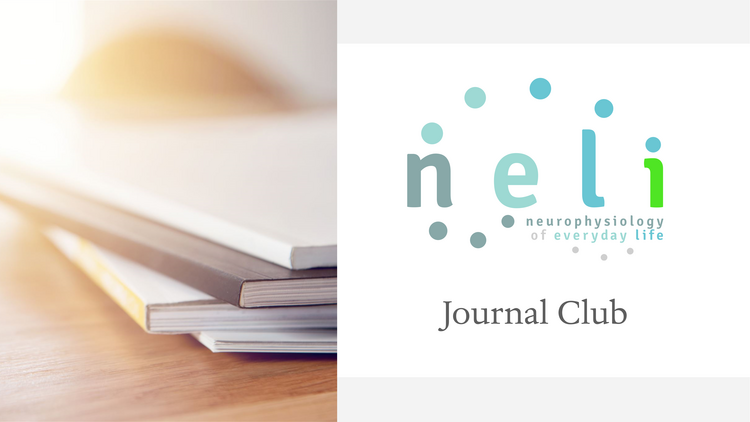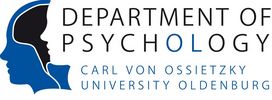Kontakt
Translationale Psychologie (» Postanschrift)
NELI Journal Club

In unserem Journal Club, der alle zwei Wochen stattfindet, diskutieren wir Forschung zu mobilem/Ohr-EEG, auditorischer Wahrnehmung, Lärmempfindlichkeit und vielem mehr. Gerne diskutieren wir auch aktuelle Preprints und geben den Autor*innen Feedback basierend auf unseren Diskussionen. Wir freuen uns immer über Vorschläge und ermutigen Autor*innen uns auf ihre Forschungsarbeiten aufmerksam zu machen. Bitte senden Sie ihre Vorschläge an Thorge Haupt.
Liste der bisher kommentierten Artikel (Preprints)
Ladouce, S., Mustile, M., & Dehais, F. (2021). Capturing cognitive events embedded in the real-world using mobile EEG and Eye-Tracking. bioRXiv 1–26. doi.org/10.1101/2021.11.30.470560
Our comments: disq.us/p/2lioepi
Knierim, M. T., Berger, C., & Reali, P. (2021). Open-Source Concealed EEG Data Collection for Brain-Computer-Interfaces. arXiv. 1-28. arxiv.org/abs/2102.00414
Our comments: Personal discussion with author
Segaert, K., Poulisse, C., Markiewicz, R., Wheeldon, L., Marchment, D., Adler, Z., Howett, D., Chan, D., Mazaheri, A. (2021). Detecting impaired language processing in MCI patients using around-the-ear cEEgrid electrodes. medRxiv. 1–23. doi.org/10.1101/2021.03.18.21253911
Our comments: disq.us/p/2g92srm
Wöstmann, M., Erb, J., Kreitewolf, J., & Obleser, J. (2021). Personality captures dissociations of subjective versus objective noise tolerance. PsyArXiv. 1–27. doi.org/10.31234/osf.io/yfes9
Our comments: Sent direcly to authors via email (German)
Liste der bisher diskutierten Artikel (chronologische Reihenfolge)
Cahn, B. R., & Polich, J. (2009). Meditation (Vipassana) and the P3a event-related brain potential. International Journal of Psychophysiology, 72(1), 51–60. https://doi.org/10.1016/j.ijpsycho.2008.03.013
Manning, J.R., Notaro, G.M., Chen, E. et al. (2022). Fitness tracking reveals task-specific associations between memory, mental health, and physical activity. Sci Rep 12, 13822. doi.org/10.1038/s41598-022-17781-0
Delorme, A. (2022). EEG is better left alone. bioRXiv. https://doi.org/10.1101/2022.12.03.518987
Schneider, D. M., & Mooney, R. (2018). How Movement Modulates Hearing. Annual Review of Neuroscience, 41(1), 553–572. doi.org/10.1146/annurev-neuro-072116-031215
Symons, A. E., Dick, F., & Tierney, A. T. (2021). Dimension-selective attention and dimensional salience modulate cortical tracking of acoustic dimensions. NeuroImage, 244(May), 118544. doi.org/10.1016/j.neuroimage.2021.118544
Studnicki, A., Downey, R. J., & Ferris, D. P. (2022). Characterizing and Removing Artifacts Using Dual-Layer EEG during Table Tennis. Sensors, 22(15). doi.org/10.3390/s22155867
Cao, L., Thut, G., & Gross, J. (2017). The role of brain oscillations in predicting self-generated sounds. NeuroImage, 147(September 2016), 895–903. doi.org/10.1016/j.neuroimage.2016.11.001
Fuglsang, S. A., Dau, T., & Hjortkjær, J. (2017). Noise-robust cortical tracking of attended speech in real-world acoustic scenes. NeuroImage, 156, 435–444. doi.org/10.1016/j.neuroimage.2017.04.026
Schlossmacher, I., Dellert, T., Bruchmann, M., & Straube, T. (2021). Dissociating neural correlates of consciousness and task relevance during auditory processing. NeuroImage, 228(June 2020), 117712. doi.org/10.1016/j.neuroimage.2020.117712
Jin, P., Zou, J., Zhou, T., & Ding, N. (2018). Eye activity tracks task-relevant structures during speech and auditory sequence perception. Nature Communications, 9(1), 5374. doi.org/10.1038/s41467-018-07773-y
Hamilton, L. S., Edwards, E., & Chang, E. F. (2018). A Spatial Map of Onset and Sustained Responses to Speech in the Human Superior Temporal Gyrus. Current Biology, 28(12), 1860-1871.e4. doi.org/10.1016/j.cub.2018.04.033
Sörqvist, P., & Rönnberg, J. (2014). Individual differences in distractibility: An update and a model. PsyCh Journal, 3(1), 42–57. doi.org/10.1002/pchj.47
Wunderlich, A., & Gramann, K. (2021). Eye movement-related brain potentials during assisted navigation in real-world environments. European Journal of Neuroscience, 54(12), 8336–8354. doi.org/10.1111/ejn.15095
Stangl, M., Topalovic, U., Inman, C. S., Hiller, S., Villaroman, D., Aghajan, Z. M., Christov-Moore, L., Hasulak, N. R., Rao, V. R., Halpern, C. H., Eliashiv, D., Fried, I., & Suthana, N. (2021). Boundary-anchored neural mechanisms of location-encoding for self and others. Nature, 589(7842), 420–425. doi.org/10.1038/s41586-020-03073-y
Zuk, N. J., Teoh, E. S., & Lalor, E. C. (2020). EEG-based classification of natural sounds reveals specialized responses to speech and music. NeuroImage, 210(December 2019), 116558. doi.org/10.1016/j.neuroimage.2020.116558
Burgess, A. P. (2012). Towards a Unified Understanding of Event-Related Changes in the EEG: The Firefly Model of Synchronization through Cross-Frequency Phase Modulation. PLoS ONE, 7(9). doi.org/10.1371/journal.pone.0045630
Gillis, M., Vanthornhout, J., Simon, J. Z., Francart, T., & Brodbeck, C. (2021). Neural Markers of Speech Comprehension: Measuring EEG Tracking of Linguistic Speech Representations, Controlling the Speech Acoustics. The Journal of Neuroscience : The Official Journal of the Society for Neuroscience, 41(50), 10316–10329. doi.org/10.1523/JNEUROSCI.0812-21.2021
Cohen, M. X. (2022). A tutorial on generalized eigendecomposition for denoising, contrast enhancement, and dimension reduction in multichannel electrophysiology. NeuroImage, 247(April 2021), 118809. doi.org/10.1016/j.neuroimage.2021.118809
Volpert-Esmond, H. I., Page-Gould, E., & Bartholow, B. D. (2021). Using multilevel models for the analysis of event-related potentials. International Journal of Psychophysiology, 162(August 2020), 145–156. doi.org/10.1016/j.ijpsycho.2021.02.006
Zink, R., Hunyadi, B., Huffel, S. Van, & Vos, M. De. (2016). Mobile EEG on the bike: Disentangling attentional and physical contributions to auditory attention tasks. Journal of Neural Engineering, 13(4). doi.org/10.1088/1741-2560/13/4/046017
Knoch, D., Pascual-Leone, A., Meyer, K., Treyer, V., & Fehr, E. (2006). Diminishing reciprocal fairness by disrupting the right prefrontal cortex. Science, 314(5800), 829–832. doi.org/10.1126/science.1129156
Strauss, D. J., Corona-Strauss, F. I., Schroeer, A., Flotho, P., Hannemann, R., & Hackley, S. A. (2020). Vestigial auriculomotor activity indicates the direction of auditory attention in humans. ELife, 9, 1–18. doi.org/10.7554/eLife.54536
Hedge, C., Powell, G., & Sumner, P. (2018). The reliability paradox: Why robust cognitive tasks do not produce reliable individual differences. Behavior Research Methods, 50(3), 1166–1186. doi.org/10.3758/s13428-017-0935-1
Stuldreher, I. V., Thammasan, N., Van Erp, J. B. F., & Brouwer, A. M. (2020). Physiological synchrony in EEG, electrodermal activity and heart rate reflects shared selective auditory attention. Journal of Neural Engineering, 17(4). doi.org/10.1088/1741-2552/aba87d
Ke, J., Zhang, M., Luo, X., & Chen, J. (2021). Monitoring distraction of construction workers caused by noise using a wearable Electroencephalography (EEG) device. Automation in Construction, 125, 103598. doi.org/10.1016/j.autcon.2021.103598
Lu, Y., Wang, M., Yao, L., Shen, H., Wu, W., Zhang, Q., Zhang, L., Chen, M., Liu, H., Peng, R., Liu, M., & Chen, S. (2021). Auditory attention decoding from electroencephalography based on long short-term memory networks. Biomedical Signal Processing and Control, 70, 102966. doi.org/10.1016/j.bspc.2021.102966
Montoya-Martínez, J., Vanthornhout, J., Bertrand, A., & Francart, T. (2021). Effect of number and placement of EEG electrodes on measurement of neural tracking of speech. PLoS ONE, 16, 1–18. doi.org/10.1371/journal.pone.0246769
Haumann, N. T., Lumaca, M., Kliuchko, M., Santacruz, J. L., Vuust, P., & Brattico, E. (2021). Extracting human cortical responses to sound onsets and acoustic feature changes in real music, and their relation to event rate. Brain Research, 1754, 147248. doi.org/10.1016/j.brainres.2020.147248
Mijović, P., Ković, V., De Vos, M., Mačužić, I., Todorović, P., Jeremić, B., & Gligorijević, I. (2017). Towards continuous and real-time attention monitoring at work: reaction time versus brain response. Ergonomics, 60(2), 241–254. doi.org/10.1080/00140139.2016.1142121
Kojima K., Oganian Y., Cai C., Findlay A., Chang E., Nagarajan S. (2021). Low-frequency neural tracking of speech amplitude envelope reflects the convolution of evoked responses to acoustic edges, not oscillatory entrainment. bioRxiv. doi.org/10.1101/2020.04.02.022616
Yoshida, K., Takeda, K., Kasai, T., Makinae, S., Murakami, Y., Hasegawa, A., & Sakai, S. (2020). Focused attention meditation training modifies neural activity and attention: Longitudinal EEG data in non-meditators. Social Cognitive and Affective Neuroscience, 15(2), 215–223. doi.org/10.1093/scan/nsaa020
Doelling, K. B., Arnal, L. H., Ghitza, O., & Poeppel, D. (2014). Acoustic landmarks drive delta-theta oscillations to enable speech comprehension by facilitating perceptual parsing. NeuroImage, 85, 761–768. doi.org/10.1016/j.neuroimage.2013.06.035
de Cheveigné, A., Wong, D. D. E., Di Liberto, G. M., Hjortkjær, J., Slaney, M., & Lalor, E. (2018). Decoding the auditory brain with canonical component analysis. NeuroImage, 172, 206–216. doi.org/10.1016/j.neuroimage.2018.01.033
Puschmann, S., Regev, M., Baillet, S., & Zatorre, R. J. (2021). MEG inter-subject phase-locking of stimulus-driven activity during naturalistic speech listening correlates with musical training. The Journal of Neuroscience, JN-RM-0932-20. doi.org/10.1523/jneurosci.0932-20.2020
Kaneshiro, B., Nguyen, D. T., Norcia, A. M., Dmochowski, J. P., & Berger, J. (2020). Natural music evokes correlated EEG responses reflecting temporal structure and beat. NeuroImage, 214, 116559. doi.org/10.1016/j.neuroimage.2020.116559
Wagner, J., Solis-Escalante, T., Grieshofer, P., Neuper, C., Müller-Putz, G., & Scherer, R. (2012). Level of participation in robotic-assisted treadmill walking modulates midline sensorimotor EEG rhythms in able-bodied subjects. NeuroImage, 63(3), 1203–1211. doi.org/10.1016/j.neuroimage.2012.08.019
Donhauser, P. W., & Baillet, S. (2020). Two Distinct Neural Timescales for Predictive Speech Processing. Neuron, 105(2), 385-393.e9. doi.org/10.1016/j.neuron.2019.10.019
Fodor, Z., Marosi, C., Tombor, L., & Csukly, G. (2020). Salient distractors open the door of perception: alpha desynchronization marks sensory gating in a working memory task. Scientific Reports, 10(1), 1–11. doi.org/10.1038/s41598-020-76190-3
Campbell, J., Nielsen, M., Bean, C., & LaBrec, A. (2020). Auditory Gating in Hearing Loss. Journal of the American Academy of Audiology. doi.org/10.1055/s-0040-1709517
Huang, N., & Elhilali, M. (2020). Push-pull competition between bottom-up and top-down auditory attention to natural soundscapes. ELife, 9, 1–22. doi.org/10.7554/eLife.52984
Fisher, A. J., Medaglia, J. D., & Jeronimus, B. F. (2018). Lack of group-to-individual generalizability is a threat to human subjects research. Proceedings of the National Academy of Sciences of the United States of America, 115(27), E6106–E6115. doi.org/10.1073/pnas.1711978115
Berger, H. (1931). Über das Elektrenkephalogramm des Menschen - Dritte Mitteilung. Archiv Für Psychiatrie Und Nervenkrankheiten, 94(1), 16–60. doi.org/10.1007/BF01835097
Ki, J. J., Kelly, S. P., & Parra, L. C. (2016). Attention strongly modulates reliability of neural responses to naturalistic narrative stimuli. Journal of Neuroscience, 36(10), 3092–3101. doi.org/10.1523/JNEUROSCI.2942-15.2016
Ellermeier, W., & Zimmer, K. (1997). Individual differences in susceptibility to the “irrelevant speech effect.” The Journal of the Acoustical Society of America, 102(4), 2191–2199. doi.org/10.1121/1.419596
Kliuchko, M., Heinonen-Guzejev, M., Vuust, P., Tervaniemi, M., & Brattico, E. (2016). A window into the brain mechanisms associated with noise sensitivity. Scientific Reports, 6, 1–9. doi.org/10.1038/srep39236
Koreimann, S., Gula, B., & Vitouch, O. (2014). Inattentional deafness in music. Psychological Research, 78(3), 304–312. doi.org/10.1007/s00426-014-0552-x
Djebbara, Z., Fich, L. B., Petrini, L., & Gramann, K. (2019). Sensorimotor brain dynamics reflect architectural affordances. Proceedings of the National Academy of Sciences of the United States of America, 116(29), 14769–14778. doi.org/10.1073/pnas.1900648116
Olguin, A., Bekinschtein, T. A., & Bozic, M. (2018). Neural encoding of attended continuous speech under different types of interference. Journal of Cognitive Neuroscience, 30(11), 1606–1619. doi.org/10.1162/jocn_a_01303
Chung, Y. S., Hyatt, C. J., & Stevens, M. C. (2017). Adolescent maturation of the relationship between cortical gyrification and cognitive ability. NeuroImage, 158, 319–331. doi.org/10.1016/j.neuroimage.2017.06.082
Hill, N. J., & Schölkopf, B. (2012). An online brain-computer interface based on shifting attention to concurrent streams of auditory stimuli. Journal of Neural Engineering, 9(2). doi.org/10.1088/1741-2560/9/2/026011
Tromp, J., Peeters, D., Meyer, A. S., & Hagoort, P. (2018). The combined use of virtual reality and EEG to study language processing in naturalistic environments. Behavior Research Methods, 50(2), 862–869. doi.org/10.3758/s13428-017-0911-9
Saiz-Alía, M., Forte, A. E., & Reichenbach, T. (2019). Individual differences in the attentional modulation of the human auditory brainstem response to speech inform on speech-in-noise deficits. Scientific Reports, 9(1), 1–10. doi.org/10.1038/s41598-019-50773-1
Dimitrijevic, A., Smith, M. L., Kadis, D. S., & Moore, D. R. (2019). Neural indices of listening effort in noisy environments. Scientific Reports, 9(1), 11278. doi.org/10.1038/s41598-019-47643-1
Ladouce, S., Donaldson, D. I., Dudchenko, P. A., & Ietswaart, M. (2019). Mobile EEG identifies the re-allocation of attention during real-world activity. Scientific Reports, 9(1), 1–10. doi.org/10.1038/s41598-019-51996-y
Kappel, S. L., Makeig, S., & Kidmose, P. (2019). Ear-EEG Forward Models: Improved Head-Models for Ear-EEG. Frontiers in Neuroscience, 13. https://doi.org/10.3389/fnins.2019.00943
Dehais, F., Roy, R. N., & Scannella, S. (2019). Inattentional deafness to auditory alarms: Inter-individual differences, electrophysiological signature and single trial classification. Behavioural Brain Research, 360, 51–59. doi.org/10.1016/j.bbr.2018.11.045
Van Ackeren, M. J., Barbero, F. M., Mattioni, S., Bottini, R., & Collignon, O. (2018). Neuronal populations in the occipital cortex of the blind synchronize to the temporal dynamics of speech. ELife, 7, 1–20. doi.org/10.7554/elife.31640
Roye, A., Jacobsen, T., & Schröger, E. (2013). Discrimination of personally significant from nonsignificant sounds: A training study. Cognitive, Affective and Behavioral Neuroscience, 13(4), 930–943. doi.org/10.3758/s13415-013-0173-7
Kaya, E. M., & Elhilali, M. (2017). Modelling auditory attention. Philosophical Transactions of the Royal Society B: Biological Sciences, 372(1714). doi.org/10.1098/rstb.2016.0101
Dmochowski, J. P., Ki, J. J., DeGuzman, P., Sajda, P., & Parra, L. C. (2018). Extracting multidimensional stimulus-response correlations using hybrid encoding-decoding of neural activity. NeuroImage, 180, 134–146. doi.org/10.1016/j.neuroimage.2017.05.037
Vatta, F., Meneghini, F., Esposito, F., Mininel, S., & Di Salle, F. (2010). Realistic and spherical head modeling for EEG forward problem solution: A comparative cortex-based analysis. Computational Intelligence and Neuroscience, 2010. doi.org/10.1155/2010/972060
Tost, H., Reichert, M., Braun, U., Reinhard, I., Peters, R., Lautenbach, S., Hoell, A., Schwarz, E., Ebner-Priemer, U., Zipf, A., & Meyer-Lindenberg, A. (2019). Neural correlates of individual differences in affective benefit of real-life urban green space exposure. Nature Neuroscience, 22(9), 1389–1393. doi.org/10.1038/s41593-019-0451-y
Cavanagh, & Frank, M. J. (2014). Frontal Theta as a Mechanism for Affective and Effective Control. Trends in Cognitive Sciences, 18(8), 414–421. doi.org/10.1016/j.tics.2014.04.012.Frontal

